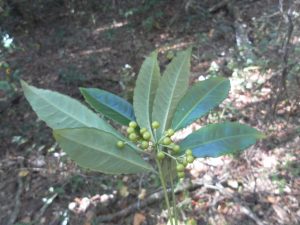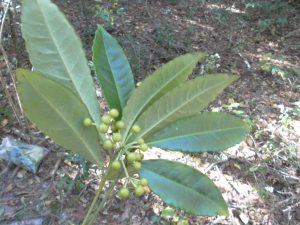Ardisia crenata (Coral ardisia, Scratchthroat)

Coral ardisia is an evergreen shrub that was introduced to Florida in 1982 as an ornamental. It has been commonly used as decoration during the Christmas holiday season (MacDonald et al. 2008). Coral ardisia is a member of the Myrsinaceae family and native to Japan and Northern India (MacDonald et al. 2008, Langeland et al. 2008, Wunderlin and Hansen 2008). Ardisia crenata is currently on the Category I list of invasive species because it can disrupt natural communities, especially hardwood hammocks which it has naturalized in (MacDonald et al. 2008). Because of the plants’ potential to grow, it can disrupt understory plant growth by reducing the amount of sunlight beneath it (MacDonald et al. 2008). In addition, seeds are numerous and are able to remain on the plant year-round, a trait which allows them to easily out-compete many other seeds when dispersed by wildlife in off seasons. Seeds are reproduced heavily two years after a fire and can withstand many soil types (acidic or alkaline) and high temperatures exceeding 25C (MacDonald et al. 2008).

Coral ardisia prefers moist soil and thrives in mesic forests, although it may be found in a variety of habitats including hammocks, sandhills, scrubs, riparian zones and other forests, shorelines or disturbed areas (MacDonald et al. 2008, Starr et al. 2008). It is typically two to three feet tall but can grow to be as high as six feet tall and often grows in clumps of 100-300 stems in a square meter (MacDonald et al. 2008,Langeland et al. 2008, Starr et al. 2008). Leaves are alternate, dark green, waxy and glabrous and can be up to 21 cm long. The leaf margins are crenate (MacDonald et al. 2008). Flowers are perfect, axillary and can be white or may have a tint of pink with yellow anthers (MacDonald et al. 2008). Fruits are bright red drupes although white berried populations have been recorded (MacDonald et al. 2008, Starr et al. 2008).

Management strategies include prevention as well as cultural, mechanical, and chemical means of controlling the plant. There are no known biological control agents for Ardisia crenata (MacDonald et al. 2008). Preventative and cultural strategies include maintaining a biodiversity of natural plants to limit establishment of A. crenata and to remove plants already in the landscape before seeds are produced. Mechanical control can be done by pulling smaller plants or disking larger infestations (MacDonald et al. 2008). Disking cuts the roots and rhizomes and is more effective than burning or cutting above ground growth, but may not be possible in some natural hammock communities. Chemical applications of glyphosate (Round-up) or triclopyr-ester can kill the plant, but caution should be taken when spraying. Because coral ardisia leaves have a waxy surface, uptake of Round-up may be limited unless a surfactant is also used (MacDonald et al. 2008).
Links:
http://plants.ifas.ufl.edu/node/42
Identification and Biology of Nonnative Plants in Florida’s Natural Areas – Second Edition
http://www.florida.plantatlas.usf.edu/Plant.aspx?id=91&display=photos
http://www.issg.org/database/species/ecology.asp?si=1285&fr=1&sts=sss&lang=EN